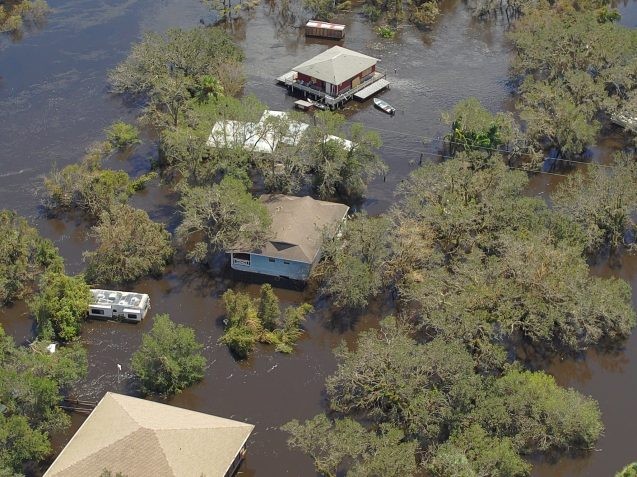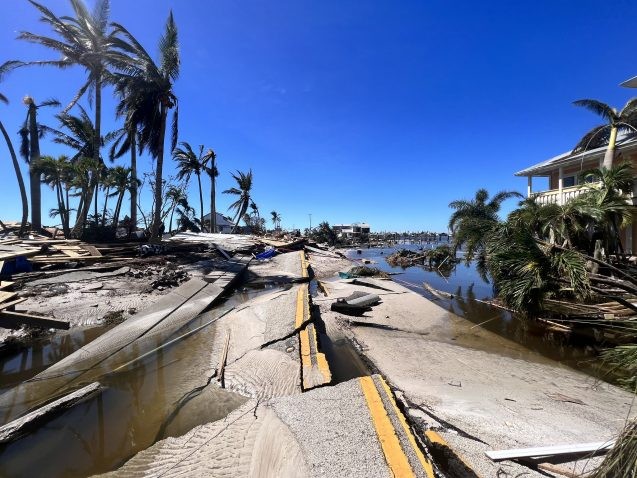Should Coastal Communities Rebuild or Retreat After Hurricane Ian?
The benefits and challenges of moving communities to safer ground.

Hurricane Ian struck Florida on September 28 and the damages are still being tallied. It may turn out to be one of the most destructive storms ever recorded in U.S. history. At least 100 deaths have been reported, making it Florida’s deadliest hurricane in a century. Power outages affected millions. Homes and businesses were destroyed, and the damages are estimated to cost at least $60 billion.
In the immediate aftermath, priorities focused on helping those impacted by the storm. Questions have also been raised about whether the state’s evacuation orders and hurricane preparedness were sufficient.
Now, as the conversation shifts from the immediate response to long-term recovery, experts are broaching the topic of managed retreat — the process of relocating homes and communities out of harm’s way.
An opinion piece in the New York Times recently noted that U.S. taxpayers are paying billions of dollars a year to rebuild properties that are repeatedly struck by disasters supercharged by climate change. The author argued that at the very least, we need to make sure these structures are rebuilt with adaptation and resilience in mind — and in some places, it’s better to pack up and move.
That’s easy enough to suggest, but harder to implement in a way that doesn’t make matters worse. Speaking with State of the Planet, Columbia Climate School experts Alex de Sherbinin and Nadia Seeteram discussed some of the challenges of managed retreat, particularly for communities like those hardest hit by Hurricane Ian.
To stay or go?
Seeteram is a postdoctoral research scientist at the Columbia Climate School’s Lamont-Doherty Earth Observatory. She studies risks and vulnerabilities around sea level rise. While working on her Ph.D. in Florida, she surveyed residents on whether they would prefer to move or stay and adapt.
“Most people wanted to adapt, but they recognize that moving might be something that they may need to consider in the long term,” said Seeteram.
De Sherbinin is a geographer who studies climate-related vulnerability and migration at the Columbia Climate School’s Center for International Earth Science Information Network. He said that there are ways to build back better and stronger — by updating building codes; using natural infrastructure such as wetlands and mangrove forests; and hardening infrastructure, by building levees and seawalls, for example.
“Each of those options needs to be weighed in local circumstances because the bathymetry, the topography, and the way wave action occurs in certain locations can be very different just a mile or so apart,” said de Sherbinin.
In some places in Florida, Seeteram noted, seawalls would not be effective because the underlying geology would allow water to seep up anyway.
Despite the overall hope that adaptation can keep these areas livable, the idea of managed retreat does seem to be catching on as hurricanes and flooding from sea level rise become more frequent and severe.
“Managed retreat is rising on the U.S. agenda,” said de Sherbinin. “And as such, it does become more politically feasible to have these conversations with communities and local planners.”

Complicating factors
There are complicated challenges to relocating homes and communities — which is one reason why de Sherbinin and Seeteram are helping to organize a Managed Retreat Conference, which is scheduled for June 22-25, 2023. Previous conferences in 2019 and 2021 emphasized the many problems that must be solved in order to carry out the managed retreat process in a fair and equitable way.
For some communities and households, the thought of leaving is unthinkable. “Their home is their single biggest investment,” explained de Sherbinin. “They have community. They have put down roots in one way or another. Moving is a very difficult thing for some people in some communities — but not all.”
This could be a particular challenge in Florida due to the higher proportion of seniors, Seeteram pointed out. “Generally, they don’t necessarily see this as a problem for their lifetime. I’ve had interviews with some seniors where they would just be like, ‘Nope, this is it, I’m not going anywhere.’ They’re on a fixed income. They can’t make any other decisions, so it’s scary.”
Even when communities do decide to relocate, the process can be long and complicated. After Hurricane Irma in 2017, a pilot program offered buyouts for 10 homes in Miami, and still to this day, those households have not received funding to relocated, said Seeteram. She explained that the delay has to do with how funding flows from the federal Department of Housing and Urban Development down to state and local governments.
“It’s a complicated process and it’s a lot to learn for state and local governments,” she said.
The complicated processes involved in managed retreat can lead to equity issues. For example, there is clear evidence that wealthier communities have been favored in FEMA buyouts, leaving behind the people with less means to protect themselves.
“Wealthier home owners are more able to avail themselves of the government assistance and to fill out the paperwork and deal with all the bureaucracy required to get money back and deal with FEMA,” explained de Sherbinin. “There is also a lack of trust in government among some communities of color.”
In Florida, gentrification is another concern as climate change pushes residents from coastlines into areas where low income and disadvantaged populations have traditionally lived.
In addition, it’s not clear whether the parts of Florida that are relatively safer from hurricane damages could accommodate a high influx of refugees from the coastal areas. The state is already suffering an affordability crisis, Seeteram pointed out, as residents find themselves homeless in the aftermath of the storm.
The need for support and transparency
Seeteram called for greater transparency around why certain communities are selected to receive buyouts.
She also pointed out that some of the communities hardest hit by Hurricane Ian are more rural and may not have the resources to navigate buyout programs. “If we want this to be equitable, there should be some support for communities to learn how to implement those programs, and training for the people on the ground such as planners and resilience experts,” she said.
For communities hoping to relocate, resources are available online, such as Georgetown University’s Managed Retreat Toolkit.
With limited government funding for relocations, “my take,” said de Sherbinin, “is that there will never be enough resources, frankly, to cover the startlingly high costs of moving so many people out of places that are being affected by climate impacts.” His advice: The first communities to move may have the advantage in terms of resources.
The power of being proactive instead of reactive
Catastrophes like Hurricane Ian always get people to start thinking seriously about managed retreat. But Seeteram argues that it’s important to start the discussion before disaster strikes, so that residents can avoid the damages in the first place, or make informed and empowered decisions during the recovery process.
“What would be really helpful is if we can use managed retreat in a proactive and strategic way as part of a toolbox of coastal adaptation options,” she said.
“There is a need for more anticipatory action,” de Sherbinin agreed. “And I think that’s one of the purposes of our Managed Retreat Conference — to bring to the fore the need to begin dialog on these topics, because often it takes a while for people to accept that this is a growing reality.”
The Managed Retreat Conference, hosted by Columbia Climate School, will be held on June 22-25, 2023. Bringing together academics with industry representatives and city and tribal leaders, the conference will discuss many of the issues mentioned above, plus more. Check here for updates.
